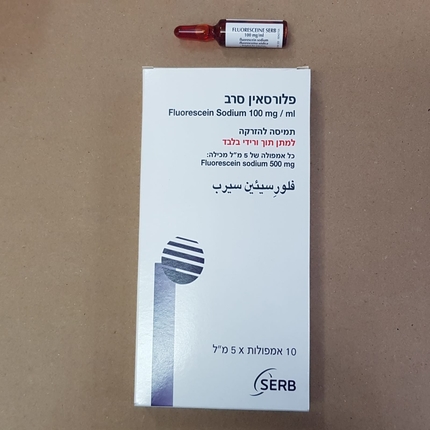Quest for the right Drug

פלורסאין סרב FLUORESCEINE SERB (FLUORESCEIN SODIUM)
תרופה במרשם
תרופה בסל
נרקוטיקה
ציטוטוקסיקה
צורת מתן:
תוך-ורידי : I.V
צורת מינון:
תמיסה להזרקה : SOLUTION FOR INJECTION
עלון לרופא
מינוניםPosology התוויות
Indications תופעות לוואי
Adverse reactions התוויות נגד
Contraindications אינטראקציות
Interactions מינון יתר
Overdose הריון/הנקה
Pregnancy & Lactation אוכלוסיות מיוחדות
Special populations תכונות פרמקולוגיות
Pharmacological properties מידע רוקחי
Pharmaceutical particulars אזהרת שימוש
Special Warning עלון לרופא
Physicians Leaflet
Adverse reactions : תופעות לוואי
4.8. Undesirable effects Summary of the safety profile The most frequently reported adverse reactions are nausea and vomiting. Less frequent, but more severe adverse reactions have been reported shortly after injection, in particular angioedema, respiratory disorders (bronchospasm, laryngeal oedema, respiratory disorders), anaphylactic shock, hypotension, loss of consciousness, respiratory arrestand cardiac arrest. Tabulated list of adverse reactions The following adverse drug reactions have been described in connection with the use of fluorescein sodium. Frequencies are defined as: very common (≥ 1/10); common (≥ 1/100 to < 1/10); uncommon (≥ 1/1,000 to < 1/100); rare (≥ 1/10,000 to < 1/1,000); very rare (< 1/10,000), or not known (cannot be estimated from the available data). MedDRA MedDRA Frequency System Organ Class Preferred Term (PT) Blood and lymphatic system Thrombocytopenia Very rare disorders MedDRA MedDRA Frequency System Organ Class Preferred Term (PT) Immune system disorders1 Anaphylactic shock, Uncommon Anaphylactic reaction, Hypersensitivity Anaphylactoid reaction Rare Nervous system disorders Loss of consciousness Uncommon Coma, syncope, seizure, Rare headache, dizziness, paraesthesia, dysgeusia, tremor Hypoaesthesia Very rare Cerebrovascular accident, Not known aphasia Cardiac disorders Cardiac arrest, acute myocardial Rare infarction, circulatory collapse, bradycardia, tachycardia Vascular disorders Hypotension Uncommon Shock, pallor, hot flush Rare Thrombophlebitis, hypertension Not known Respiratory, thoracic and Laryngeal oedema, asthma, Rare mediastinal disorders dyspnoea, cough, throat irritation, sneezing, bronchospasm Respiratory arrest, pulmonary Very rare oedema Respiratory disorder, throat Not known tightness Gastrointestinal disorders Vomiting, nausea Uncommon Abdominal pain Rare Salivary hypersecretion Very rare Retching Not known Skin and subcutaneous tissue Rash, erythema, urticaria, Uncommon disorders pruritus Dermatitis, hyperhidrosis, skin Rare discolouration2 Cold sweat Very rare Renal and urinary tract Chromaturia3 Rare disorders MedDRA MedDRA Frequency System Organ Class Preferred Term (PT) General disorders and Extravasation4, malaise Uncommon administration site conditions Chest pain, oedema, asthenia, Rare feeling hot, chills Infusion site thrombosis, pain Not known 1 Hypersensitivity reactions, including rare cases of anaphylactic/anaphylactoid shock, which may have fatal outcome. 2 A yellowish discoloration of the skin may appear following administration, but usually disappears within 6 to 12 hours. 3 Urine, which may also exhibit a bright yellow colouration, returns to its normal colour after 24 to 36 hours. 4 Extravasation of the solution which causes intense pain and may be followed by tissue necrosis (see section 4.4 Special warnings and precautions for use). Reporting of suspected adverse reactions Reporting suspected adverse reactions after authorization of the medicinal product is important. It allows continued monitoring of the benefit/risk balance of the medicinal product. Any suspected adverse events should be reported to the Ministry of Health according to the National Regulation by using an online form /https://sideeffects.health.gov.il

שימוש לפי פנקס קופ''ח כללית 1994
Diagnostic
תאריך הכללה מקורי בסל
01/01/1995
הגבלות
תרופה מוגבלת לשימוש בבתי חולים או אשפוז יום
מידע נוסף
